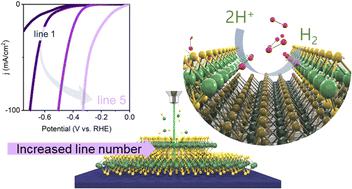当前位置:
X-MOL 学术
›
J. Mater. Chem. A
›
论文详情
Our official English website, www.x-mol.net, welcomes your feedback! (Note: you will need to create a separate account there.)
Path-dependent hydrogen evolution reaction via selective etching of bilayer MoS2 catalysts
Journal of Materials Chemistry A ( IF 10.7 ) Pub Date : 2024-08-22 , DOI: 10.1039/d4ta03197k Min Jung 1 , Jungmoon Lim 1 , Junsung Byeon 1 , Taehun Kim 1 , Younghoon Lim 1 , Hongju Park 1 , Jaesik Eom 1 , Seungsub Lee 1 , Sangyeon Pak 2 , SeungNam Cha 1
Journal of Materials Chemistry A ( IF 10.7 ) Pub Date : 2024-08-22 , DOI: 10.1039/d4ta03197k Min Jung 1 , Jungmoon Lim 1 , Junsung Byeon 1 , Taehun Kim 1 , Younghoon Lim 1 , Hongju Park 1 , Jaesik Eom 1 , Seungsub Lee 1 , Sangyeon Pak 2 , SeungNam Cha 1
Affiliation

|
Molybdenum disulfide (MoS2) is being considered as a promising candidate for replacing noble metal catalysts in the hydrogen evolution reaction (HER). However, low active site density, semiconducting properties, and electrochemically inert basal planes limit the catalytic performance of MoS2 catalysts. Therefore, various strategies have been developed for activating basal planes in MoS2 catalysts. Here, we propose an efficient laser technology for activating basal planes and creating controlled artificial patterns. The precisely controlled laser etching technique allows for etching only the top layer of the bilayer MoS2 catalyst, and using this technique, the appropriately etched area increases the active sites without any degradation of catalytic performance, enabling efficient carrier injection. The catalytic behavior of line patterned MoS2 exhibited line density dependent catalytic performance. Compared with pristine MoS2 catalysts, the etched catalysts with 5 lines in a specific area (L5-MoS2) showed a decreased overpotential and Tafel slope up to 65.1% and 73.7%, respectively. Moreover, in the case of L5-MoS2 devices, the vertical contact between the etched line and electrode exhibited improved catalytic performance with a low Tafel slope and charge transfer resistance, which is mainly attributed to the facilitated charge transfer induced rapid charge exchange process at the electrolyte/catalyst interface. This effective strategy proposes a controllable defect engineering technique for improving the catalytic performance in 2D TMDC catalysts.
中文翻译:

通过选择性蚀刻双层 MoS2 催化剂进行路径依赖的析氢反应
二硫化钼(MoS 2 )被认为是替代析氢反应(HER)中贵金属催化剂的有前途的候选者。然而,低活性位点密度、半导体性质和电化学惰性基面限制了MoS 2催化剂的催化性能。因此,已经开发了多种策略来活化MoS 2催化剂中的基面。在这里,我们提出了一种有效的激光技术来激活基底平面并创建受控的人工图案。精确控制的激光蚀刻技术允许仅蚀刻双层MoS 2催化剂的顶层,并且使用该技术,适当蚀刻的区域增加了活性位点,而不会降低催化性能,从而实现高效的载流子注入。线状图案MoS 2的催化行为表现出线密度依赖的催化性能。与原始MoS 2催化剂相比,在特定区域具有5条线的蚀刻催化剂(L5-MoS 2 )表现出降低的过电势和塔菲尔斜率分别高达65.1%和73.7%。此外,在L5-MoS 2器件的情况下,蚀刻线和电极之间的垂直接触表现出改善的催化性能,具有低塔菲尔斜率和电荷转移电阻,这主要归因于促进的电荷转移诱导的快速电荷交换过程。电解质/催化剂界面。 这种有效的策略提出了一种可控缺陷工程技术,用于提高 2D TMDC 催化剂的催化性能。
更新日期:2024-08-22
中文翻译:

通过选择性蚀刻双层 MoS2 催化剂进行路径依赖的析氢反应
二硫化钼(MoS 2 )被认为是替代析氢反应(HER)中贵金属催化剂的有前途的候选者。然而,低活性位点密度、半导体性质和电化学惰性基面限制了MoS 2催化剂的催化性能。因此,已经开发了多种策略来活化MoS 2催化剂中的基面。在这里,我们提出了一种有效的激光技术来激活基底平面并创建受控的人工图案。精确控制的激光蚀刻技术允许仅蚀刻双层MoS 2催化剂的顶层,并且使用该技术,适当蚀刻的区域增加了活性位点,而不会降低催化性能,从而实现高效的载流子注入。线状图案MoS 2的催化行为表现出线密度依赖的催化性能。与原始MoS 2催化剂相比,在特定区域具有5条线的蚀刻催化剂(L5-MoS 2 )表现出降低的过电势和塔菲尔斜率分别高达65.1%和73.7%。此外,在L5-MoS 2器件的情况下,蚀刻线和电极之间的垂直接触表现出改善的催化性能,具有低塔菲尔斜率和电荷转移电阻,这主要归因于促进的电荷转移诱导的快速电荷交换过程。电解质/催化剂界面。 这种有效的策略提出了一种可控缺陷工程技术,用于提高 2D TMDC 催化剂的催化性能。





































 京公网安备 11010802027423号
京公网安备 11010802027423号